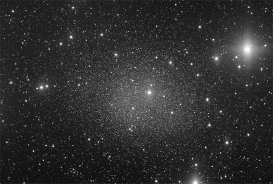Table of Contents
Spherical & Triaxial
 These mock data are designed to mimic spherical/triaxial collisionless stellar systems (e.g. dwarf galaxies and giant elliptical galaxies). Key questions include:
These mock data are designed to mimic spherical/triaxial collisionless stellar systems (e.g. dwarf galaxies and giant elliptical galaxies). Key questions include:
(1) What quality of data are required to determine the mass profile? (2) How can we best break the degeneracy between velocity anisotropy and mass? (3) How badly do we do if we assume spherical symmetry but the galaxy is actually triaxial?
Key working group coordinator: Justin Read
Summary of 2015 Gaia Challenge: Summary GCIII
The default mock data suite
The default mocks are designed to cover the following tests:
-
- Cusped and cored
- Isotropic; Osipkov Merritt; Tangential anisotropy
- Plummer light; cuspy light
- Sampling: 10^2, 10^3, 10^4
- Split population: Perfect (wide scale length sep); Sampled
- Measurement error
- Contamination (binaries, foreground)
Priority order of runs
We realise that the above mocks about to a very large number of tests which for some methods may be prohibitive. For this reason, if you can only run some of the tests the priority order is as follows:
- Spherical isotropic models viewed along z with velocity errors and 10,000 stars.
- Spherical radially anisotropic models viewed along z with velocity errors and 10,000 stars.
- Spherical tangentially anisotropic models viewed along z with velocity errors and 10,000 stars.
- The above with lower sampling (1000 stars; 100 stars). You may prefer to do the sampling tests just for one system in which case start with the isotropic models, as above.
- Split component models (if your method is capable of this; again with velocity error).
- Triaxial models with velocity error and 10,000 star sampling. Try projections along X (long axis); and the intermediate axis I.
- Tidally stripped models with velocity error and 10,000 star sampling.
In all cases projections should be along the z-axis.
The default outputs
- Cumulative mass profile with 68%/95% confidence intervals (i.e. 1 and 2-sigma equivalent) and median of the distribution
- Density versus radius (with confidence intervals as above)
- <latex>$d\ln\rho/d\ln r$</latex> (with confidence intervals as above)
- Anisotropy profile (with confidence intervals as above); <latex>$\beta® = 1 - \sigma_\theta^2/\sigma_r^2$</latex>
- Projected light number density profile with conf. intervals
- 3D light density profile with conf. intervals
- Projected velocity dispersion profile with conf. intervals
- Please output over the largest radial range feasible for your chosen technique
Example: Units: kpc, Msun, km/s File format: ASCII columnated (headings allowed). Example:
| Projected/or 3D radius (kpc) | Cumulative mass (Msun) [2.3% low] | [15.9% low] | Median [50%] | [84.1% high] | [97.7% high] |
|---|---|---|---|---|---|
| 0.2 | 1e3 | 1e4 | 1e5 | 1e6 | 1e10 |
Publication policy
If using the spherical test data, please cite the Gaia Challenge wiki and http://adsabs.harvard.edu/abs/2011ApJ...742...20W. For further details of our publication policy see publications.
If using the triaxial test data, please cite the Gaia Challenge wiki and http://adsabs.harvard.edu/abs/2009MNRAS.395.1079D, as the data for this test were generated using the Made-to-Measure (M2M) N-body code from Dehnen 2009. For further details of our publication policy see publications.
Results
Results from running the above using a variety of techniques can be found here.
Discussion
Gary
Questions on outputs
- Accuracy of outputs (say 3 digits or more after the decimal point. The poor accuracy of the example is misleading).
- Methods ought to provide important numbers as well as profiles:
- * inner DM slope
- * inner stellar slope
- * half-projeted-mass radius <latex>$R_{1/2}$</latex> (<latex>$R_{\rm eff}$</latex> in ellitpical galaxy parlance) and uncertainty (although one could numerically estimate it by fitting <latex>$\nu®$</latex> and projecting).
- Should we provide maximum likelihood estimation (MLE) values of the profiles as well? This seems relevant for the DM density profiles of <latex>$\gamma_{\rm DM}$</latex> (core DM) models, for which the median slope is not 0, but the MLE slope is.
- Could add <latex>$J_{\rm LOS}$</latex> and <latex>$J_{\rm ap}$</latex> (line-of-sight and aperture terms for the γ-ray emission from DM annihilation).
Questions on comparisons of methods
- Do we wish to make quantitative comparisons between methods, or simply compare them graphically?
- If we wish to make quantitative comparisons, which measures shall we use?
- * Bias and scatter at specific radii such as <latex>$R_{\rm eff}^{\rm true}$</latex>?
- * RMS difference with true profile between some radii (in linear or logarithmic bins?)?
Other questions
Can we still bring in new methods to this 3rd GAIA Challenge?
